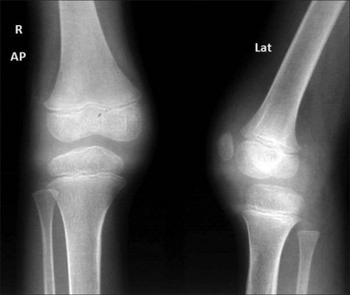Camptodactyly-arthropathy-coxa vara-pericarditis syndrome
Camptodactyly-arthropathy-coxa vara-pericarditis syndrome is a rare autosomal recessive genetic condition due to a mutation in the gene proteoglycan 4 (PRG4) – a mucin-type glycoprotein that acts as a lubricant for the cartilage surfaces. This gene is also known as lubricin.
Symptoms and signs

This condition was first described in 1986.[1] and is a syndrome of camptodactyly, arthropathy, coxa vara and pericarditis.[2]
It may also include congenital cataracts.[3]
The cause of this syndrome was discovered in 1999.[4]
Children with this syndrome often present with a joint effusion that is cool and resistant to anti-inflammatory therapy. The arthropathy principally involves large joints such as elbows, hips, knees, and ankles. Pericarditis may be a presenting feature or may occur later in the course of the disease. Coxa vara occurs in 50–90% of cases and noninflammatory pericarditis in 30%.
Genetics
The gene responsible for this condition is located on the long arm of chromosome 1 (1q). The encoded protein is a glycoprotein of ~345 kDa[5] specifically synthesized by chondrocytes located at the surface of articular cartilage, and also by some synovial lining cells. The cDNA encodes a protein of 1,404 amino acids (human A isoform) with a somatomedin B homology domain, heparin-binding domains, multiple mucin-like repeats, a hemopexin domain, and an aggregation domain. There are 3 consensus sequences for N-glycosylation and 1 chondroitin sulfate substitution site.
Diagnosis
Laboratory
The full blood count, erythrocyte sedimentation rate and C reactive protein are normal.
Synovial fluid is typically viscous, clear, honey-colored, and low in cell count. Synovial histology shows little or no mononuclear infiltration. Mild thickening of the synovium is present and giant cells may be occasionally seen.
Radiology
Large acetabular cysts are common in this condition.[2] Other features include periarticular osteopenia, squaring of metacarpals and phalanges and bilateral joint effusions.
Management
CACP syndrome at present has no cure. Physical therapy and pain medication can relieve the symptoms , while hip joint replacement surgery may be an option.[6]
References
- ↑ Bulutlar G, Yazici H, Ozdogan H, Schreuder I (1986) A familial syndrome of pericarditis, arthritis, camptodactyly and coxa vara. Arthritis Rheum 29:436–438
- ↑ 2.0 2.1 Offiah AC, Woo P, Prieur AM, Hasson N, Hall CM (2005) Camptodactyly-arthropathy-coxa vara-pericarditis syndrome versus juvenile idiopathic arthropathy. AJR Am J Roentgenol 185(2):522-529
- ↑ Akawi NA, Ali BR, Al-Gazali L (2012) A novel mutation in PRG4 gene underlying camptodactyly-arthropathy-coxa vara-pericarditis syndrome with the possible expansion of the phenotype to include congenital cataract. Birth Defects Res A Clin Mol Teratol doi: 10.1002/bdra.23031.
- ↑ Marcelino J, Carpten JD, Suwairi WM, Gutierrez OM, Schwartz S, Robbins C, Sood R, Makalowska I, Baxevanis A, Johnstone B, Laxer RM, Zemel L, Kim CA, Herd JK, Ihle J, Williams C, Johnson M, Raman V, Alonso LG, Brunoni D, Gerstein A, Papadopoulos N, Bahabri SA, Trent JM, Warman ML (1999) CACP, encoding a secreted proteoglycan, is mutated in camptodactyly-arthropathy-coxa vara-pericarditis syndrome. Nat Genet 23(3):319-322
- ↑ Su JL, Schumacher BL, Lindley KM, et al. (June 2001). "Detection of superficial zone protein in human and animal body fluids by cross-species monoclonal antibodies specific to superficial zone protein". Hybridoma. 20 (3): 149–57. doi:10.1089/027245701750293475. PMID 11461663.
- ↑ "Camptodactyly arthropathy coxa vara pericarditis syndrome | Genetic and Rare Diseases Information Center (GARD) – an NCATS Program". rarediseases.info.nih.gov. Archived from the original on 18 March 2021. Retrieved 9 September 2021.
External links
| Classification | |
|---|---|
| External resources |
